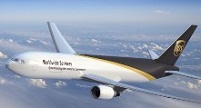UPS increased Q1, 2012 net profits by 6 per cent despite continued slow exports from Asia as its USdomestic business grew strongly thanks to more e-commerce shipments, and executives reiterated the
full-year outlook and their confidence in regulatory approval of the TNT Express takeover.In the January-March first quarter, UPS increased its consolidated revenue by 4.4 per cent to$13.14 billion and the company delivered approximately 1 billion packages, a 4.3 per cent increase.Operating profit improved 6.6 per cent to $1.57 billion, raising the operating margin to 11.9 percent from 11.7 per cent in Q1, 2011. Net profit came in at $970 million, up 6 per cent and pushingthe net profit margin up slightly to 7.4 per cent.
“These results demonstrate that UPS is providing its customers with the solutions needed fortoday’s ever-changing market conditions,” said Scott Davis, UPS chairman and CEO. “We will continueto invest and develop innovative services that facilitate global commerce, ensuring UPS’s long-termsuccess.”
The US Domestic Package business performed strongly, with revenues rising 6.1 per cent to $8billion and operating profit up 13.1 per cent to $995 million. The profit margin improved 0.7percentage points to 12.4 per cent. Daily volume increased 4.5 per cent, with Next Day Air up 5 percent and Deferred up 9.9 per cent. Ground volume improved 4 per cent on strong demand forlightweight shipping options.
CFO Kurt Kuehn told analysts that the new ‘Sure Post’ service, targeted mostly ate-retailers, was generating new lighter volumes “that we have not competed for in the past”.E-commerce shipments were using both Air and Ground services, with “the vast majority” using theNext Day Air Saver service for non-time-definite next-day deliveries, typically delivered in theafternoon.
Davis said the acquisition of European B2C company Kiala and the introduction of My Choiceresponded to the B2C trends. UPS achieved a milestone during the quarter when the millionth userenrolled in My Choice, the consumer-based delivery solution rolled out in October 2011. My Choiceusers received more than 7 million shipments and used the service to conveniently control thedelivery of 1 million packages.
The International Package division, in contrast, suffered a 9.9 per cent drop in operatingprofit to $408 million even though revenues rose 2.3 per cent to $2.97 billion. The operatingmargin declined to 13.8 per cent from 15.6 per cent. Revenue per piece was down 2.2 per cent,though up 2 per cent on a currency-neutral basis.
UPS Export volume growth continued to outpace the market at 5.4 per cent, with solid gains inEurope, intra-Asia and Mexico. US and European exports grew at “mid-single-digit” rates, Kuehnsaid. A key factor, however, was the decline in exports on high-yield routes from Asia, leavingAsia as a whole “relatively flat” despite higher intra-Asia volumes, he explained. However, Asiawas slightly firmer in March and April, he added.
During the quarter, UPS increased cargo capacity by more than 50 per cent on 20 weeklyflights in Latin America and expanded its air infrastructure for western Mexico by establishing aregular flight to Guadalajara.
On the subject of TNT Express, Davis told analysts that UPS had had a couple of meetings withregulators. The formal offer will be filed by May 11 and the European Commission will be officiallyinformed by mid-May. “UPS remains confident about receiving all the necessary approvals,” hecommented. But it was too early to discuss any possible divestitures, he added in a response to ananalyst’s query.
UPS’ Supply Chain & Freight division improved operating profit by 19 per cent to $166million in Q1 on revenue growth of 1.3 per cent to $2.17 billion. The operating margin expanded 120basis points to 7.7 per cent. Forwarding & Logistics revenues dropped 0.3 per cent to $1.4billion with lower Forwarding lower tonnage and yields due to excess market capacity. Demand forUPS healthcare solutions drove revenue gains in the Logistics business unit and the operatingmargin expanded despite the impact of continued investment in the healthcare network. UPS plans toopen five more healthcare facilities this year, giving it 38 sites around the world.












